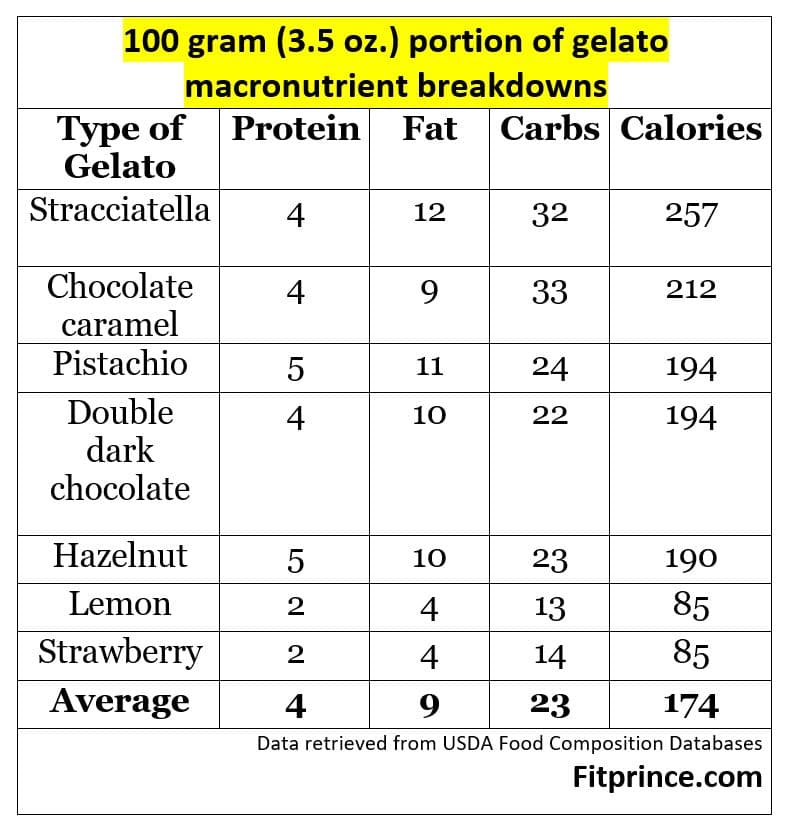While I was visiting Italy, I allowed myself to step out of my strict fitness regimen and ate many, many cups of gelato. It was so delicious. Without a doubt, it became my favorite Italian treat. I know many other people who also choose gelato and ice cream to satisfy a sweet tooth, especially on hot summer days.
As with most sweets, the main problem boils down to sugar and high calorie contents. No one wants to eat too much and add to their waistline. So, you might start wondering which would be the better choice, gelato or ice cream, to more easily control your daily caloric intake.
I did some homework and compared gelato versus ice cream calories.
What are the main differences?
Before we plunge straight into calorie counts, let us briefly discuss the difference between gelato and ice cream.
Basically, gelato is an Italian name for ice cream. However, they taste a bit different, and there are two main reasons why:
First, in terms of ingredients, they are very similar, they are just made with a different ratio. Ice cream consists of more cream, and consequently has more fat than gelato. Typically, ice cream could even have up to two times more cream than you would find in gelato. On the other hand, gelato might have more sugar.
Second, gelato is denser and contains less air than ice cream. That’s due to slight differences in preparation methods.
Gelato vs. ice cream calories
On average, gelato contains 174 calories per 100 grams (3.5 oz.) versus ice cream’s 244 calories.
What is the reason for such a big difference?
In a word – fat!
As you already know, ice cream has more fat than gelato. One gram of fat is equal to 9 calories, while protein and carbs only have 4 calories. Hence, higher fat contents boost the number of calories in ice cream.
At first glance, it seems that everything is clear and ice cream is more energy dense than gelato. However, I want to mention that we are talking only about mean caloric values. Below, are two tables showing examples of various types of gelato and ice cream and their macronutrient breakdowns.


As you can see, the caloric values fluctuate greatly among these frozen desserts. We can quickly find examples where the leanest ice creams contain fewer calories than the fattiest gelato. Hence, I can’t say that a cup of gelato will always be a better choice than a cup of ice cream in terms of caloric intake.
Additionally, you can buy different ice creams of the same flavor but with 100 calorie gaps between them. The reason for this is that producers can make ice cream or gelato using fattier or skimmer ingredients. As a result, calories can go up or down. For instance, pistachio ice cream produced from high-calorie ingredients like cream, pistachio, egg yolks, and so on has 259 calories. Meanwhile, pistachio light ice cream with low-calorie ingredients provides only 94 calories.
To sum it up, on average, gelato provides less calories compared to ice cream. However, if you are looking for very accurate nutritional information, it’s preferable to check food labels before buying any product.
How to reduce calories
Generally speaking, neither ice cream nor gelato are among the highest calorie foods, like, nuts, which have over 500 calories per 100 grams (3.5 oz.).
Anyway, I want to share with you a few tips on how to cut down on calories and still enjoy ice cream or gelato without worrying about exceeding your daily caloric budget.
- Opt for ice cream or gelato with fruit flavors. Usually, they tend to have lower calorie amounts. For instance, chocolate caramel gelato has 212 calories while lemon gelato has only 85 calories.
- Look for specially labeled low-calorie products.
- Don’t add any fatty toppings, they add extra calories.
- Ask for your ice cream or gelato in a cup instead of a cone, it can add an additional 50 calories.
- You can buy or order ice cream in smaller servings and even cut the calories in half!
Low calorie alternatives
If you want to try something else from the frozen dessert aisle other than gelato or ice cream, I want to draw your attention to three low-calorie alternatives.
Sorbet
Usually, sorbet is made from fruit, water, sweetener (sugar, honey, stevia, etc.), and supplemented with some flavoring ingredients. You can find dozens of recipes online and prepare sorbet at home. All sorbets are very low in calories. For instance, strawberry sorbet has only 85 calories per 100 grams (3.5 oz.).
Frozen yogurt
Another low-calorie alternative to ice cream and gelato is frozen yogurt. The biggest nutritional difference is the fat content. For instance, 100 grams (3.5 oz.) vanilla ice cream contains 356 calories and 25 grams of fat while the same amount of vanilla frozen yogurt contains 169 calories and only 6 grams of fat.
Frozen banana ice cream
This is one you can very easily prepare at home. The recipe is very simple and some time ago become a big hit on the internet.
You just need to peel a few ripe bananas and chop them into smaller pieces. After that, put them in the freezer for at least two hours. Then, transform your frozen bananas into a blender and use the pulse function to blend until it gets to a thick, creamy texture. Now, you get a tasty and healthy dessert.
It doesn’t matter whether you prefer gelato or ice cream, but I advise you to eat both in moderation. They aren’t considered as healthy food, you should limit them in your diet.
Reference
- Thompson, Kelly R, Delores H Chambers, and Edgar IV Chambers. “Sensory Characteristics of Ice Cream Produced In the U.s.a. and Italy.” Journal of sensory studies, v. 24,.3 pp. 396-414. doi: 10.1111/j.1745-459X.2009.00217.x
- Book: Ice Cream.
- Book: The Science of Ice Cream.







Leave a Reply